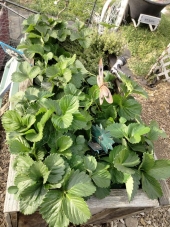
 2
2




"Study books and observe nature; if they do not agree, throw away the books." ~ William A. Albrecht





List of Bryant RedHawk's Epic Soil Series Threads We love visitors, that's why we live in a secluded cabin deep in the woods. "Buzzard's Roost (Asnikiye Heca) Farm." Promoting permaculture to save our planet.




Medicinal herbs, kitchen herbs, perennial edibles and berries: https://mountainherbs.net/ grown in the Blue Mountains, Australia




"Study books and observe nature; if they do not agree, throw away the books." ~ William A. Albrecht




 1
1




















I sliced it vertically down the center with a razor blade, and the interior is a tobacco brown color. I compared what I was looking at with photos on an ag extension website (forget which university it was) and it looked uncannily like a dead crown that succumbed to disease (verticillium wilt if memory serves me correct, which it sometimes does not).
Perhaps I mulched too thick and things stayed too wet and couldn't breathe. All I did was follow the guidelines from the nursery to mulch 4 to 6 inches of straw.
List of Bryant RedHawk's Epic Soil Series Threads We love visitors, that's why we live in a secluded cabin deep in the woods. "Buzzard's Roost (Asnikiye Heca) Farm." Promoting permaculture to save our planet.




 2
2




"Study books and observe nature; if they do not agree, throw away the books." ~ William A. Albrecht












 1
1




List of Bryant RedHawk's Epic Soil Series Threads We love visitors, that's why we live in a secluded cabin deep in the woods. "Buzzard's Roost (Asnikiye Heca) Farm." Promoting permaculture to save our planet.
 3
3




"Study books and observe nature; if they do not agree, throw away the books." ~ William A. Albrecht
 4
4






 2
2




 4
4




"Study books and observe nature; if they do not agree, throw away the books." ~ William A. Albrecht













| I agree. Here's the link: http://stoves2.com |



